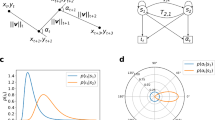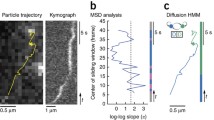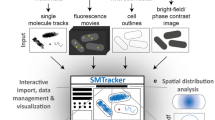Abstract
Many organelles and vesicles in live cells move in a start–stop manner when observed for ~10 s by optical microscopy. Changes in velocity and directional persistence of such particles are a potentially rich source of insight into the mechanisms leading to the start and stop states. Unbiased assessment of the most probable number of states, the properties of each state, and the most probable state for the particle at each moment can be accomplished by variational Bayesian methods combined with a hidden Markov model and a Gaussian mixture model. Our track analysis method, “vbTRACK”, applied this combination of methods to particle velocity v or changes in the direction of travel evaluated from simulated tracks and from tracks of peroxisomes in live cells. When tested with numerical data, vbTRACK reliably determined the number of states, the mean and variance of the velocity or the direction of travel for each state, and the most probable state during each frame. When applied to the tracks of peroxisomes in live cells, some tracks separated into two states, one with high velocity and directionality, the other approximately Brownian. Other tracks of particles in live cells separated into several diffusive states with distinct diffusion constants.










Similar content being viewed by others
References
Allen RD, Weiss DG, Hayden JH et al (1985) Gliding movement of and bidirectional transport along single native microtubules from squid axoplasm: evidence for an active role of microtubules in cytoplasmic transport. J Cell Biol 100:1736–1752. doi:10.1083/jcb.100.5.1736
Arcizet D, Meier B, Sackmann E et al (2008) Temporal analysis of active and passive transport in living cells. Phys Rev Lett 101:248103. doi:10.1103/PhysRevLett.101.248103
Attias H (1999) Inferring parameters and structure of latent variable models by variational Bayes. In Laskey KB, Prada H (eds) Uncertainty in artificial intelligence: proceedings of the fifteenth conference on uncertainty in artificial intelligence. Elsevier/Morgan Kaufmann, Burlington, pp 21–30
Bishop CM (2006) Pattern recognition and machine learning. Springer, Hidelberg
Bronson JE, Fei J, Hofman JM et al (2009) Learning rates and states from biophysical time series: a Bayesian approach to model selection and single-molecule FRET data. Biophys J 97:3196–3205. doi:10.1016/j.bpj.2009.09.031
Bruno L, Salierno M, Wetzler DE et al (2011) Mechanical properties of organelles driven y microtubule-dependent molecular motors in living cells. PLoS One 6:e18332
Gittes F, Mickey B, Nettleton C, Howard J (1993) Flexural rigidity of microtubules and actin filaments measured from thermal fluctuations in shape. J Cell Biol 120:923–930
Hill DB, Plaza MJ, Bonin K, Holzwarth G (2004) Fast vesicle transport in PC12 neurites: velocities and forces. Eur Biophys J Biophys Lett 33:623–632. doi:10.1007/s00249-004-0403-6
Luby-Phelps K (2000) Cytoarchitecture and physical properties of cytoplasm: volume, viscosity, diffusion, intracellular surface area. Int Rev Cytol 192:189–221
MacKay DJC (1992) Bayesian interpolation. Neural Comput 4:415–427
Monnier N, Guo S-M, Mori M et al (2012) Bayesian approach to MSD-based analysis of particle motion in live cells. Biophys J 103:616–626. doi:10.1016/j.bpj.2012.06.029
Persson F, Linden M, Unoson C, Elf J (2013) Extracting intracellular diffusive states and transition rates from single-molecule tracking data. Nat Methods 10:265–269. doi:10.1038/NMETH.2367
Press WH, Teukolsky SA, Vetterling WT, Flannery BP (2007) 7.3.2 Transformation method in general. Numerical recipes, 3rd edn. Cambridge University, Cambridge, pp 362–363
Rőding M, Guo M, Weitz D et al (2014) Identifying directional persistence in intracellular particle motion using hidden Markov models. Math Biosci 248:140–145. doi:10.1016/j.mbs.2013.12.008
Ross JL, Ali MY, Warshaw DM (2008) Cargo transport: molecular motors navigate a complex cytoskeleton. Curr Opin Cell Biol 20:41–47
Saxton MJ (2007) A biological interpretation of transient anomalous subdiffusion. I Qual Model Biophys J 92:1178–1191
Smelser AM, Macosko JC, O’Dell AP et al (2015) Mechanical properties of normal versus cancerous breast cells. Biomech Model Mechanobiol. doi:10.1007/s10237-015-0677-x
Türkcan S, Alexandrou A, Masson J-B (2012) A Bayesian inference scheme to extract diffusivity and potential fields from confined single-molecule trajectories. Biophys J 102:2288–2298. doi:10.1016/j.bpj.2012.01.063
Viterbi AJ (1967) Error bounds for convolutional codes and an asymptotically optimum decoding algorithm. IEEE Trans Inf Theory 13:260–269. doi:10.1109/TIT.1967.1054010
Weihs D, Gilad D, Seon M, Cohen I (2012) Image-based algorithm for analysis of transient trapping in single-particle trajectories. Microfluid Nanofluid 12:337–344. doi:10.1007/s10404-011-0877-3
Zajac AL, Goldman YE, Holzbaur ELF, Orsag EM (2013) Local cytoskeletal and organelle interactions impact molecular-motor-driven early endosomal trafficking. Curr Biol 23:1173–1180
Acknowledgments
This material is based upon work supported by the National Science Foundation under Grant Number 1106105 (GH). MJM was supported by a Summer Research Grant from Wake Forest University. AMS was supported by National Institutes of Health (T32GM095440) and National Science Foundation graduate fellowship 0907738. We thank J. Bronson, J. Fei, J. Hofman, R. Gonzalez, C. Wiggins, E. Khan, K. Murphy, I. Nabney, and M. Beal for making their programs freely available. We also thank Jed Macosko and Keith Bonin for use of cell culture and video microscopy facilities.
Author information
Authors and Affiliations
Corresponding author
Electronic supplementary material
Below is the link to the electronic supplementary material.
Rights and permissions
About this article
Cite this article
Martin, M.J., Smelser, A.M. & Holzwarth, G. Dividing organelle tracks into Brownian and motor-driven intervals by variational maximization of the Bayesian evidence. Eur Biophys J 45, 269–277 (2016). https://doi.org/10.1007/s00249-015-1091-0
Received:
Revised:
Accepted:
Published:
Issue Date:
DOI: https://doi.org/10.1007/s00249-015-1091-0




